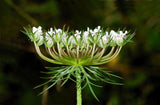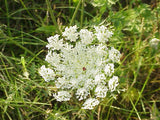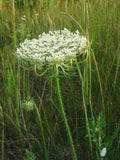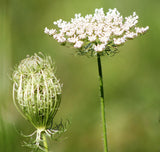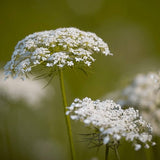Daucus carota Seeds — Lace of History, Wings of Wildlife
Plant more than seeds—plant a legacy. Wild Carrot, or Queen Anne’s Lace, drapes the summer sky with feathery umbels that carry pollen-speckled wonders and centuries of poetry in their lace-like bloom.
Bloom Color & Form
-
Bloom Appearance: Clusters of delicate white, lacy umbels, often edged in creamy petals, with the occasional tiny central floret in deep purple or red—a striking jewel in a crown of silk.
-
Structure: These umbrella-like flowerheads measure 3–6 inches wide, supported by erect, hair-roughened stems reaching up to 5 feet in its biennial prime.
Hardiness & Growth
-
USDA Hardiness Zones: Exceptionally adaptable, thriving across Zones 3–11—able to weather harsh winters and sunny fields alike.
-
Life Cycle: A biennial charmer: first year it forms a rosette of fern-like leaves; second year it blooms in delicate grandeur before setting seed.
Fragrance & Pollinator Appeal
-
Fragrance: Unassuming and subtle; this species favors visual allure and nectar over scent.
-
Wildlife Magnet: Flowers brim with nectar and pollen, attracting bees, butterflies, wasps, flies, and even beneficial wasps like Gasteruption, creating a summer sanctuary for the busy and winged.
-
Larval Host: Known as a host plant for Eastern Black Swallowtail caterpillars, this plant supports the butterfly's full life cycle—an ecosystem thread in garden tapestry.
Cultural and Historical Significance
-
Ancestral Roots of the Carrot: This wild form is the very ancestor of the cultivated carrot, representing the tangled heritage of fields past and the dawn of domestication.
-
Queen Anne’s Lace Legend: Legend places a single red floret at the button of the umbel to honor Queen Anne, pricking her finger while crafting lace—an homage wrapped in floral fashion.
-
Art, Poetry & History: Iconic in art, symbol, and verse—including a beloved poem by William Carlos Williams—its presence connects gardeners to centuries of human imagination.
Practical Charm & Cottage-Garden Grace
-
Scenic Self-Seeder: Scatter these seeds and watch the lace cascade naturally—meadow, border, or roadside, Queen Anne blooms with carefree confidence.
-
Companion Sensibility: Its umbels attract beneficial insects, aiding vegetable plots—boosting nearby blueberries, enhancing pollinator corridors.
-
Cautionary Note: Though enchanting, it can naturalize aggressively; managing seedheads curbs unwanted spread.






